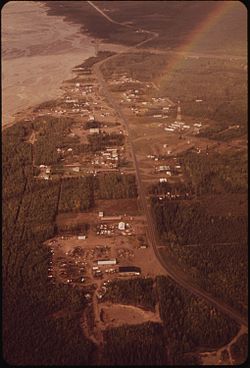Delta Junction, Alaska
| Delta Junction | |
|---|---|
| City | |

Aerial view showing Delta Junction and neighboring Big Delta, as it appeared in 1973.
|
|
| Location in Alaska | |
| Coordinates: 64°02′52″N 145°43′07″W / 64.04778°N 145.71861°WCoordinates: 64°02′52″N 145°43′07″W / 64.04778°N 145.71861°W | |
| Country | United States |
| State | Alaska |
| Census Area | Southeast Fairbanks |
| Incorporated | December 1960 |
| Government | |
| • Mayor | Peter "Pete" Hallgren |
| • State senator | Mike Dunleavy (R) |
| • State rep. | George Rauscher (R) |
| Area | |
| • Total | 17.3 sq mi (44.7 km2) |
| • Land | 17.3 sq mi (44.7 km2) |
| • Water | 0 sq mi (0 km2) |
| Elevation | 1,158 ft (353 m) |
| Population (2010) | |
| • Total | 958 |
| Time zone | Alaska (AKST) (UTC-9) |
| • Summer (DST) | AKDT (UTC-8) |
| ZIP code | 99737 |
| Area code | 907 |
| FIPS code | 02-18620 |
| GNIS feature ID | 1401104 |
| Website | ci |
Delta Junction is a city in the Southeast Fairbanks Census Area, Alaska, United States. According to 2012 population estimate, the number of residents in Delta Junction city area is 974. The city is located a short distance south of the confluence of the Delta River with the Tanana River, which is at Big Delta. It is about 160 km (99 mi) south of Fairbanks. Native inhabitants are Tanana Athabaskans.
For at least 10,000 years, Athabascan Indians have inhabited portions of the interior of Alaska. Early inhabitants survived by hunting and fishing.
The early history of non-native settlement in the area occurred at the river crossing at Big Delta and is found at the entry, Big Delta, Alaska. In 1904, the town first served as a telegraph station. In 1928 a herd of 23 bison were brought from the National Bison Range in Montana to an area south of Big Delta to provide an additional game species for hunters. Buffalo Center, a small community near the center of present-day Delta Junction, was named because of their presence, especially during the winter months. The huge animals were troublesome, and sometimes made landings dangerous at nearby Allen Army Airfield.
The herd is now kept at several hundred animals by the annual issuance of hunting permits. In the early 1980s, the 90,000-acre (360 km2) Delta Junction Bison Range, south of the Alaska Highway and between Ft. Greely and the Little Gerstle River was established; the range is now managed by the Alaska Department of Fish and Game to provide fall habitat for bison to reduce farm depredations and to provide habitat for other wildlife.
During World War II the United States aided the Soviet Union against Germany by sending airplanes and supplies authorized by the Lend-lease Act to the Soviet Union through Alaska into the Russian Far East. The Alaska Highway was built to connect an existing road in Dawson Creek, British Columbia, Canada, with the Richardson Highway in Alaska, a distance of 2,290 km (1,420 mi).
...
Wikipedia

